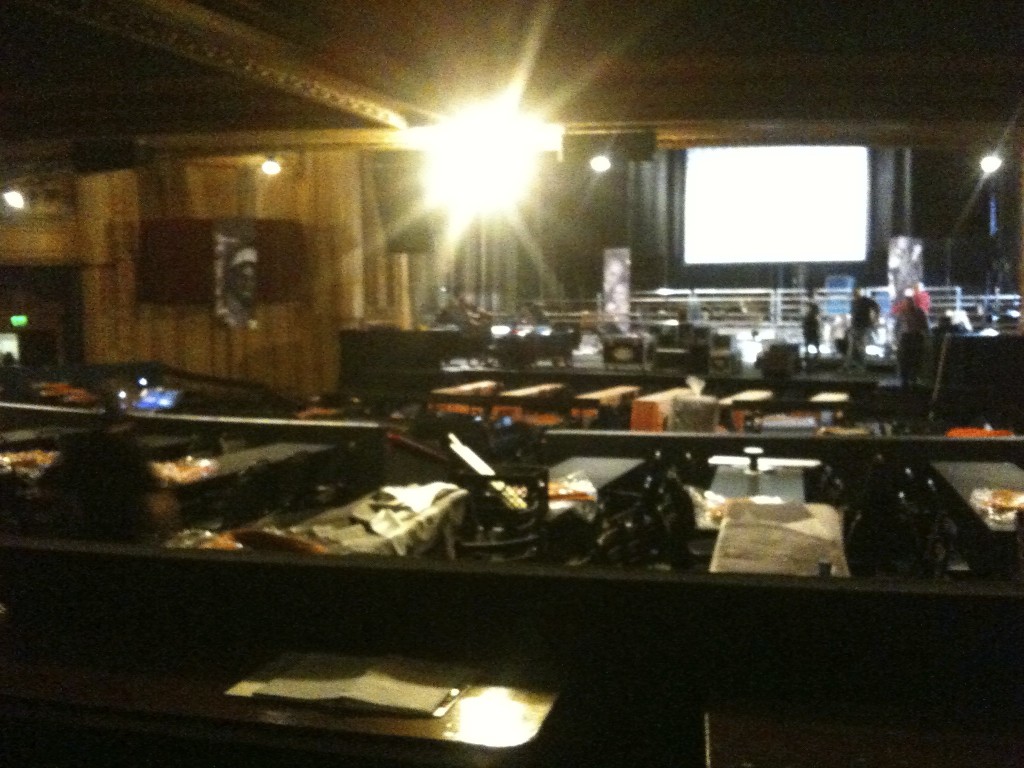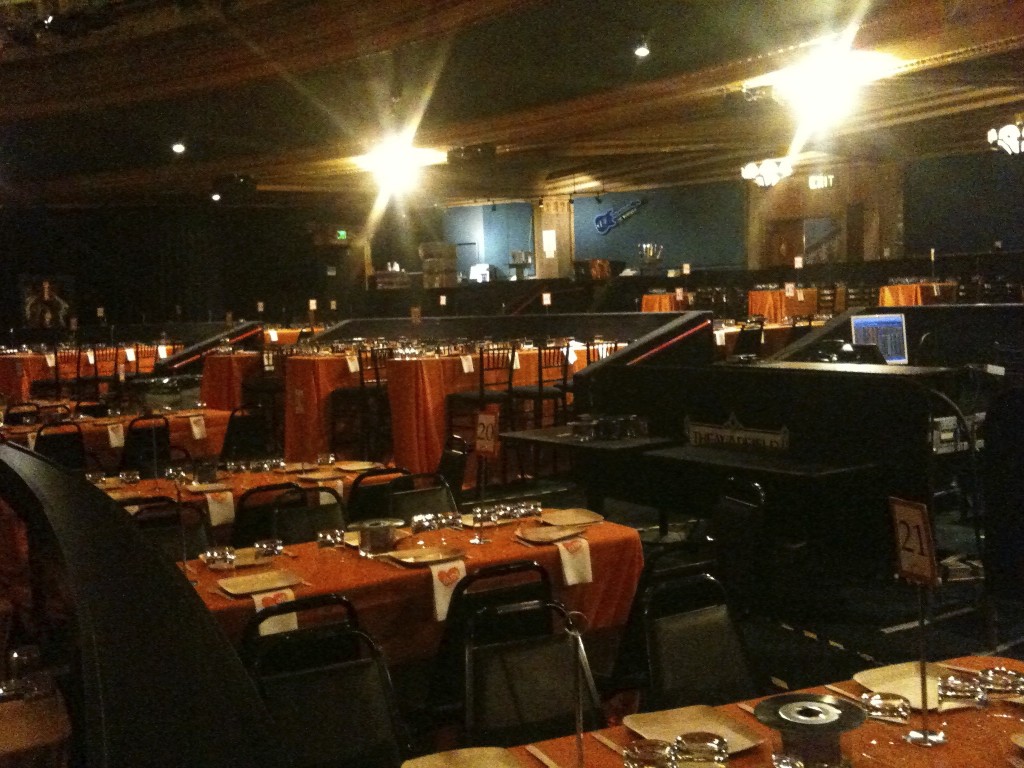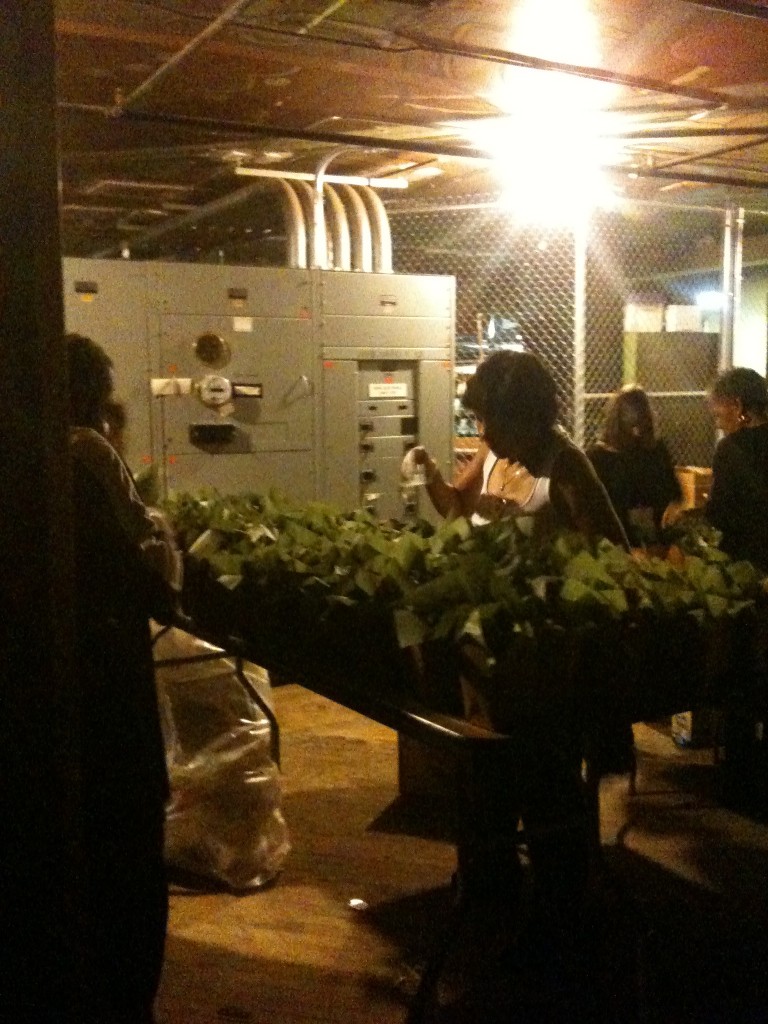
Cecil Williams, the Reverend Cecil Williams, leader of Glide Memorial Church for many years created one of the most internationally respected non-profit organizations that help the homeless and the hungry. Reverend Williams retired in 2007 but the Glide Memorial Church and the Glide Memorial Church’s homeless outreach program still continues under the direction of many dedicated people. This year, I decided to try my hand in helping out, so I signed on for some volunteer work. I signed up to help this week, but didn’t realize what I was signing up to do.
What I signed up for was to help set up Glide Annual Holiday Jam, where all the big wigs of the city, plus everyone else who wants to see and be seen attend. The professionalism of the set-up crew was unbelievable. On the first day, I chose to help with the decor plans.
There was a really cool table setting design using old 45 rpm records and LED tea-lights. In the meantime, another of our volunteer crew climbed up to the rafters to install the lighting. Our supervisor from Winslow, Sandra, was a bright young woman from Fremont. “I’m planning on moving to Florida to study staging design,” Sandra told us while we worked feverishly on the table settings. With us were Kathy and Kate. Kathy is a former mergers-and-acquisitions wall street person while Kate is a sophomore at San Francisco State studying microbiology. It is this rather disparate group of people that come together to volunteer their time and effort and bring their unique skills and knowledge that makes volunteering at Glide such a wonderful experience.
Our task for the day was to create 210 table settings. Each setting was made up of a 45 rpm disk, a special Glide Holiday Jam record label applied to the record’s center. Then the 45 was taped to the top of an opened glass cube, which had a purple streamer paper encircled in the inside of the cube, and an LED tea-light placed in the middle. Kathy and I did the labels while Sandra and Kate wrapped the inside of the cubes with the streamer paper and placed the tea-light in the middle.
They handed the cube to us and then we also taped the 45 to the top of the glass cube. As expected, the first few cubes took some time to set up. After a short while, we all learned how to perform our individual roles better and better. One of the interesting thing one learns when working with one’s hands is that, very quickly, one develops a sense of rhythm and skill in doing the task. Soon, we were all humming along nicely as we finished set after set. In due time, we filled up one table with the 45-on-a-glass-cube set, forty such settings on the table. Then another forty settings on another table. Then another. Then, stacked atop the existing settings as we ran out of tables to store them.

We then broke for lunch and chatted some more while figuring out our next steps. We needed to place the settings on the actual dining tables, but have to wait for the table cloths to be put on first. So in the meantime, we went around to check on the secondary tasks.
Mine was to fill up the forks and paper napkins for the vendors’ stations. Kathy was working with Kate down in the kitchen. At around 3 PM, the table cloth crew came in and dressed up the tables. We then set our settings on the tables, three to a large table, one to the small tables. (Sandra’s mantra: “odd number of settings work better than even numbers.” Listen to her, she’s an expert.) We didn’t turn on the LED tea-lights, because that would have drained the batteries. So the tea-lights still have to be turned on the next day, together with the placing two drumsticks through the center of the 45s and into the glass cube.
Day one was done with minimal volunteering help, as ten no-shows slowed the scheduling of completing the tasks.
I wasn’t scheduled to return the next day, but since I was available and enjoyed the first day, I went back to help out. Since I was the only volunteer who returned, I was deputized as assistant supervisor since I know what was going on. I led a group of volunteers to help complete the table settings.
Now, we just had to put the plates and utensils and napkins for each seat. Some were already done by other staff members, but not all tables were fully set. We had to walk through all tables to check for missing utensils or drinking glasses or whatever else was missing.
After that was completely, we had to return to the tables after one other server mentioned that the extra drinking glasses should be placed on the end of the table away from the common walk areas, so they people won’t accidentally knock them down. So I and four other volunteers walked through the whole room again, rearranging each table’s extra glassware to a safer location. This sounds like a bad supervisory leadership, as it caused redundant work.

We finished eventually and I headed downstairs to the kitchen area. There was more work to be done: 200 boxed meals for the VIPs. I and Stan worked on popping open the cardboard box lunch carriers. Two other women stuffed a green filler paper into the bottom of the box. Oops, a mistake as the paper is supposed to go in “random” looking, not neatly folded to fit into the bottom. So I stopped setting up the boxes and helped re-do the filler paper. Then, I placed a plate on top of the green paper.
The plates, much like all other eating implements, are made of bamboo so they’re compostable. Here we are: 200 boxes, filled first with green filler paper. Then I went through each and placed a plate in each. Then, the sandwiches came. The sandwich was turkey (or chicken?) and cheese and a piece of lettuce on a small, 3-inch long italian roll. I was to open face the sandwich (so that the diner can put her choice of condiments) and rest the two pieces diagonally on the plate. Boom, I flew down the long table of boxes and filled them out.

Once done, someone else – not a volunteer – went by and dropped a mayonnaise and mustard packet. Another crew member went by after that and closed up the boxes and placed them on a pallet to bring up to the main hall. In the meantime, I took s stroll into the guts of the Warfield Theater, seeing the very bottom of the building. Its eerie silence, clean but desolate basement seemed haunted by the ghosts of past performers.

I then went back to the main hall and together with another volunteer went through all the table settings, turning on the LED tea-lights and placing the two drumsticks into the middle. That ran for about forty minutes. Then, back down to the kitchen to help with the appetizer plates. The appetizer plate consisted of a quarter wedge of brie, three kalamata olives, a few sprigs of parsley, a dried piece of bread with two slices of cheddar or jarlsberg (not clear), a bruschetta and two large prawns sitting in cocktail sauce.
This time, because it’s for all guests, and not just the VIPs, there were 800 servings of this.We had ten long tables set up with the bamboo plates filling the tables. Two volunteers held the brie tray while four others picked out handful and dropped them onto the plate. The scene was amazing. People who’ve never done this before were humming along like a well-oiled engine.

My role, as I returned after others have started, was to fill up whatever was missing. You’d think since the task is rather mindless and automatic that one couldn’t possible screw things up. But it happens. Every once in a while, there’s a plate missing a brie wedge, or missing some olives. Also the placement of the food items had to be correct. They’re not randomly placed on the plate; no, they had to be placed properly for the proper look. And, frankly, it does make it seem more appetizing when it’s nicely arranged. Time was running by quickly. We found out that someone – the head chef – miscalculated the amount of bruschetta to make. Son only the first 200 or so got the bruschetta. We didn’t have anything appropriate for the remaining 600+ diners.
Our supervisor, subordinate to the head chef, a mild-mannered and well experienced middle-aged woman, quickly made the executive decisions for what to do. That was great, because we didn’t have time to dawdle around contemplating what to feed the guests. They were already entering the theater just that moment. The supervisor decided to add extras for the dessert and hope everyone enjoyed the whole meal.
Once the main meal with the brie, olives, parsley springs, two large prawns, two slices of cheese on a toast and some with bruschetta were taken off the setting tables by the servers, we immediately placing new plates on the setting table and started on the desserts. Dessert consisted of two chocolate chip cookies, truffles, and four (count ’em!) pieces of chocolate. It was a diabetic’s death sentence. Heck, I could even feel my pancreas work overtime from just looking at the cookies.

Again, despite having people doing very rote work, we somehow managed to miss a plate or two. Thus, we had secondary people go over the plates to make sure each plate had enough dessert elements. Now, the problem was that we ran out of plates. No problem, able-minded supervisor quickly decided on using bowls for the remaining 60 servings. Now, 200 servings of dessert, all ready to go. The servers came back down, filled their trays with dessert plates (and bowls) and ran back up to the main stage area to place the food for the guests.

After the food settings were completed, we were essentially done for the day. We could, if we chose, stay and watch the program from the loge seating area. I hung around to snap some photos, but decided to head home, feeling comfortable, slightly weary and very satisfied in helping a great San Francisco cause. For more information on Glide or how to get involved, you can visit them here.








